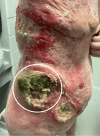Atypical Cutaneous Manifestation of Mycosis Fungoides: A Case Report
- PMID: 39165452
- PMCID: PMC11334760
- DOI: 10.7759/cureus.65034
Atypical Cutaneous Manifestation of Mycosis Fungoides: A Case Report
Abstract
Mycosis fungoides (MF) is a cutaneous T-cell lymphoma (CTCL) that is characterized by atypical CD4+ T-cell aggregates in the epidermis. It is typically divided into three clinical phases, which consist of the patches, plaques, and tumor stages. There have been atypical manifestations of MF described in the literature, and it is hypothesized that the skin microbiota plays a role in the skin phenotype of MF patients. Here, we describe an MF patient with multiple, large, ulcerated, and purulent lesions that developed after she swam in the ocean. Our patient was found to have a unique set of bacteria isolated from the wound.
Keywords: atypical manifestation; bacterial superinfection; mycosis fungoides; primary cutaneous t-cell lymphoma; skin microbiota.
Copyright © 2024, Hagan et al.
Conflict of interest statement
Human subjects: Consent was obtained or waived by all participants in this study. Conflicts of interest: In compliance with the ICMJE uniform disclosure form, all authors declare the following: Payment/services info: All authors have declared that no financial support was received from any organization for the submitted work. Financial relationships: All authors have declared that they have no financial relationships at present or within the previous three years with any organizations that might have an interest in the submitted work. Other relationships: All authors have declared that there are no other relationships or activities that could appear to have influenced the submitted work.
Figures
References
-
- Mycosis fungoides-clinical and histopathologic features, differential diagnosis, and treatment. Cerroni L. Semin Cutan Med Surg. 2018;37:2–10. - PubMed
-
- Mycosis fungoides and Sezary syndrome. Hwang ST, Janik JE, Jaffe ES, Wilson WH. Lancet. 2008;15:945–957. - PubMed
-
- The skin microbiome in cutaneous T-cell lymphomas (CTCL)-a narrative review. Łyko M, Jankowska-Konsur A. https://doi.org/10.3390/pathogens11080935. Pathogens. 2022;11:935. - PMC - PubMed
Publication types
LinkOut - more resources
Full Text Sources
Research Materials


